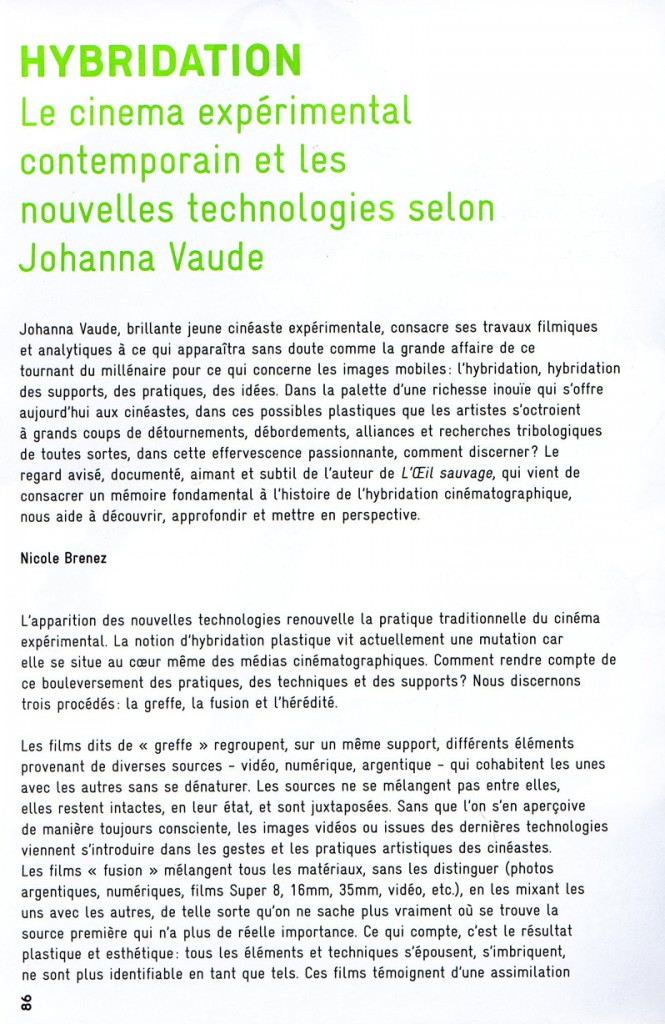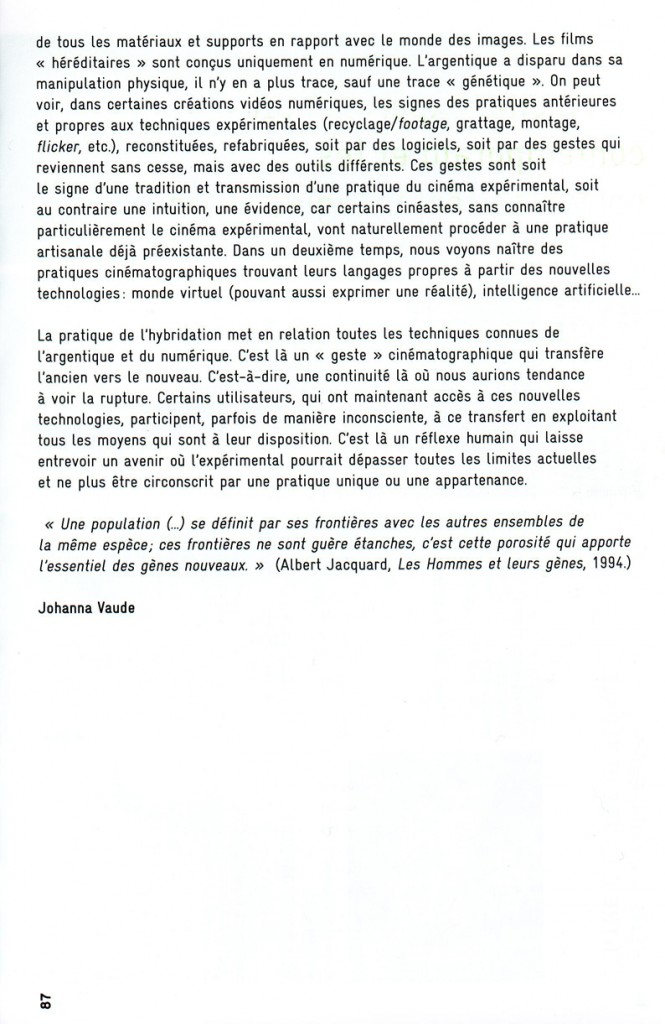![]() English translation below
English translation below
« Hybridation : Le cinéma expérimental contemporain et les nouvelles technologies selon Johanna Vaude » in Cinémathèque Française, programme Septembre – Octobre 2006, p. 86,87

HYBRIDIZATION IN CONTEMPORARY EXPERIMENTAL CINEMA WITH NEW TECHNOLOGIES ACCORDING TO JOHANNA VAUDE
Program of the « Cinémathèque Française » (French Anthology Film Archives)_ Paris, September / October 2006, p.86-87
« Johanna Vaude, brilliant young experimental film-maker, dedicates her cinematic and analytical works to what will doubtless appear as the big affair of this turning point of the millennium as regards the mobile images : hybridization, the hybridization of supports, practices, ideas. In the palette of an incredible wealth available to the film-makers today, in these plastics possibilities that the artists grant themselves through repeated and various diversions, excesses, alliances and tribologiques researches, in this fascinating excitement, how to distinguish ? The informed, sensible and subtle glance of the author of “The Wild Eye”, which has just dedicated a fundamental essay to the history of the film hybridization, helps us to discover, to look from different view points. »
Nicole Brenez
« The appearance of the new technologies renews the traditional practice of the experimental movies. The notion of plastic hybridization is nowadays subject to changes because it is situated in the heart of the film media. How to report this disruption of the practices, techniques and supports ? We discern three processes: the transplant, the fusion and the heredity.
The « Transplant » films include, on the same support, the various elements from diverse sources – video, digital, film – which live together without becoming distorted. The sources do not mix, they remain intact, in their state, and are juxtaposed. Without our noticing it consciously, the videos images or those from of the last technologies come into gestures and artistic practices of the filmmakers.
The « Fusion » films mix all the materials, without distinguishing them (photos, digital, Super 8 films, 16mm, 35mm, video, etc.), by mixing them, so that we do not know anymore where is the first source, which is not important anymore. What counts, is the plastic and aesthetic result : all the elements and the techniques marry, are linked, are not anymore recognizable as such. These films attest of an assimilation of all the materials and the supports in relation with the world of the images.
The « hereditary » films are only on digital. The film disappeared in its physical manipulation, there is no more trace, except a « genetic » trace. We can see, in certain digital videos works, the signs of previous practices and the experimental techniques (recycling / footage, scratching, assembly (editing), flicker, etc.)
We can see, in certain videos digital creations, the signs of the previous practices specific the experimental, (recycling / footage, scratching, editing, flicker, etc.), reconstituted techniques, remade either by software or by gestures that come back constantly, but with different tools. These gestures are either the sign of a tradition and a transmission of a practice of the experimental movies, or on the contrary an intuition, an evidence, because certain filmmakers, without knowing particularly the experimental movies, are naturally going to proceed with an already pre-existent home-made practice.
Subsequently, we see new film practices finding their specific languages from the new technologies: virtual world (being also able to express a reality), artificial intelligence…
The practice of hybridization puts in touch all the techniques of the film and the digital technology. It is a film « gesture » which transfers the old to the new. That is a continuity where we would see a break. Some users, who have now access to these new technologies, participate, sometimes unconsciously, in this transfer by using all the means at their disposal.
It is a human reflex which let hope a future where the experimental could exceed all the current limits and lease to be confined in a unique practice or a belonging. »
Johanna Vaude
« A population (…), is defined by its borders with the other groups of the same kind; these borders are hardly waterproof, it is this porosity which brings the main part of the new genes. »
(Albert Jacquard, Les hommes et leurs gènes, 1994.)


